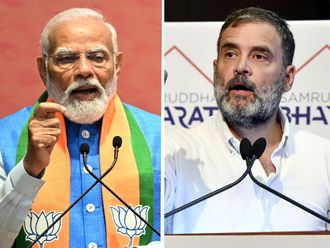New Delhi: India and the United States began a massive joint military exercise yesterday, underscoring deepening security ties which both sides view as crucial in a troubled South Asia region.
Hundreds of soldiers using heavy transport aircraft and battle tanks are participating in the biggest-ever war games between the two countries which were on the opposing sides of the Cold War but now seek to build strategic and military ties.
"This exercise is a clever policy for India, a correct thing to do and is clearly part of a larger programme started by both countries to improve relations by shedding old inhibitions," Naresh Chandra, a former envoy to Washington, said.
The two countries share security concerns centred around Pakistan and Afghanistan, and New Delhi seeks to enlist American support to press Islamabad to tackle militants on its soil. They also both share concerns about a rising China.
Washington is increasingly realising the impact of the India-Pakistan rivalry on efforts to stabilise Afghanistan.
"Afghanistan and Pakistan will remain areas of concern for both countries and the US, instead of leaving Afghanistan as a theatre, is looking to quarantine the security threat in the region itself," said Uday Bhaskar, a strategic analyst.
"Therefore, this tactical exercise between the two countries to prepare their troops for future makes sense," Bhaskar, director of the National Maritime Foundation, said.
The military exercise comes after 17 people were killed last week in a bomb attack on the Indian embassy in Kabul that renewed focus on India's tense relations with Pakistan.
Pakistan remains suspicious of India's involvement in Afghanistan —where New Delhi is spending $1.2 billion (Dh4.4 billion) on development projects — and fears being squeezed between India on the east and a hostile Afghanistan, backed by India, to the west.
The exercise will also allow Indian military officials to assess some of the American defence equipment being offered for sale to India.
For New Delhi, the growing ties with Washington are also a counterweight against China, which India fears could be trying to strategically encircle it as they jostle for resources and global influence.
With an ally in India, Washington also seeks to keep an eye on the Chinese army's growing military mobility and strength in the area.
Official claims success
India successfully test-fired a nuclear-capable missile yesterday with a range of 350 kilometres, a defence ministry official said. The test was considered routine and unlikely to aggravate tensions with Pakistan.
The surface-to-surface missile, Prithvi-II, was fired twice within five minutes from a range in Chandipur, in the eastern state of Orissa, the official said on condition of anonymity as he was not authorised to talk to reporters.
The missile can carry a warhead weighing up to 500 kilogrammes, he said. The Indian army already has inducted a shorter version of the missile, Prithvi-I, with a range of 150 kilometres. It can carry both conventional and nuclear warheads.
India's current crop of missiles is mostly intended for confronting neighbouring Pakistan. The two countries routinely test-fire missiles, but usually notify each other ahead of the launches in keeping with an agreement. They have been holding peace talks since 2004 aimed at resolving their differences including the contentious Kashmir issue. The two countries have fought three wars since their independence from Britain in 1947.












